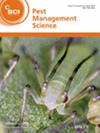求助PDF
{"title":"南韩 Vespa velutina Lepeletier, 1836 的生态整合:与本地社会蜂共存和互动模式的综合研究。","authors":"Woong-Bae Park, Yuno Do, Moon Bo Choi","doi":"10.1002/ps.8348","DOIUrl":null,"url":null,"abstract":"<p><strong>Background: </strong>The spread of Vespa velutina Lepeletier, 1836 (Asian hornet) in South Korea poses a threat to biodiversity and agriculture. Traditional species interaction models often fail to capture the complexity of invasive species dynamics. This study used association rule learning (ARL) and clustering analyses to explore the interactions of V. velutina with native Vespidae species in South Korea, with the aim of uncovering patterns of coexistence and competition.</p><p><strong>Results: </strong>Over 4 years (2020-2023), 304 traps were strategically placed across South Korea to collect data on Vespidae species. Our findings showed that Vespula flaviceps, Vespa crabro, and Vespula koreensis were the most frequently encountered species. V. velutina was also widespread, suggesting its successful integration into local ecosystems. The ARL analysis, using the 'apriori' algorithm, identified significant co-occurrence patterns and potential interactions. The rules generated indicated both competitive and coexistent relationships with varying levels of association strength across different regions. Clustering analyses, including hierarchical and k-means clustering, grouped species based on their occurrence similarities. The distinct clusters formed in the analysis highlighted the unique ecological roles and interactions of V. velutina and other Vespidae species in South Korean ecosystems.</p><p><strong>Conclusion: </strong>This study confirms the successful establishment of V. velutina in diverse South Korean ecosystems and highlights its complex interactions with native species. These findings support the need for nuanced management strategies that consider the intricate ecological relationships of V. velutina. This approach is crucial for the effective management of invasive species and ecosystem conservation. © 2024 The Author(s). Pest Management Science published by John Wiley & Sons Ltd on behalf of Society of Chemical Industry.</p>","PeriodicalId":218,"journal":{"name":"Pest Management Science","volume":null,"pages":null},"PeriodicalIF":3.8000,"publicationDate":"2024-08-01","publicationTypes":"Journal Article","fieldsOfStudy":null,"isOpenAccess":false,"openAccessPdf":"","citationCount":"0","resultStr":"{\"title\":\"Ecological integration of Vespa velutina Lepeletier, 1836 in South Korea: a comprehensive study of co-occurrence and interaction patterns with native social wasps.\",\"authors\":\"Woong-Bae Park, Yuno Do, Moon Bo Choi\",\"doi\":\"10.1002/ps.8348\",\"DOIUrl\":null,\"url\":null,\"abstract\":\"<p><strong>Background: </strong>The spread of Vespa velutina Lepeletier, 1836 (Asian hornet) in South Korea poses a threat to biodiversity and agriculture. Traditional species interaction models often fail to capture the complexity of invasive species dynamics. This study used association rule learning (ARL) and clustering analyses to explore the interactions of V. velutina with native Vespidae species in South Korea, with the aim of uncovering patterns of coexistence and competition.</p><p><strong>Results: </strong>Over 4 years (2020-2023), 304 traps were strategically placed across South Korea to collect data on Vespidae species. Our findings showed that Vespula flaviceps, Vespa crabro, and Vespula koreensis were the most frequently encountered species. V. velutina was also widespread, suggesting its successful integration into local ecosystems. The ARL analysis, using the 'apriori' algorithm, identified significant co-occurrence patterns and potential interactions. The rules generated indicated both competitive and coexistent relationships with varying levels of association strength across different regions. Clustering analyses, including hierarchical and k-means clustering, grouped species based on their occurrence similarities. The distinct clusters formed in the analysis highlighted the unique ecological roles and interactions of V. velutina and other Vespidae species in South Korean ecosystems.</p><p><strong>Conclusion: </strong>This study confirms the successful establishment of V. velutina in diverse South Korean ecosystems and highlights its complex interactions with native species. These findings support the need for nuanced management strategies that consider the intricate ecological relationships of V. velutina. This approach is crucial for the effective management of invasive species and ecosystem conservation. © 2024 The Author(s). Pest Management Science published by John Wiley & Sons Ltd on behalf of Society of Chemical Industry.</p>\",\"PeriodicalId\":218,\"journal\":{\"name\":\"Pest Management Science\",\"volume\":null,\"pages\":null},\"PeriodicalIF\":3.8000,\"publicationDate\":\"2024-08-01\",\"publicationTypes\":\"Journal Article\",\"fieldsOfStudy\":null,\"isOpenAccess\":false,\"openAccessPdf\":\"\",\"citationCount\":\"0\",\"resultStr\":null,\"platform\":\"Semanticscholar\",\"paperid\":null,\"PeriodicalName\":\"Pest Management Science\",\"FirstCategoryId\":\"97\",\"ListUrlMain\":\"https://doi.org/10.1002/ps.8348\",\"RegionNum\":1,\"RegionCategory\":\"农林科学\",\"ArticlePicture\":[],\"TitleCN\":null,\"AbstractTextCN\":null,\"PMCID\":null,\"EPubDate\":\"\",\"PubModel\":\"\",\"JCR\":\"Q1\",\"JCRName\":\"AGRONOMY\",\"Score\":null,\"Total\":0}","platform":"Semanticscholar","paperid":null,"PeriodicalName":"Pest Management Science","FirstCategoryId":"97","ListUrlMain":"https://doi.org/10.1002/ps.8348","RegionNum":1,"RegionCategory":"农林科学","ArticlePicture":[],"TitleCN":null,"AbstractTextCN":null,"PMCID":null,"EPubDate":"","PubModel":"","JCR":"Q1","JCRName":"AGRONOMY","Score":null,"Total":0}
引用次数: 0
引用
批量引用
Ecological integration of Vespa velutina Lepeletier, 1836 in South Korea: a comprehensive study of co-occurrence and interaction patterns with native social wasps.
Background: The spread of Vespa velutina Lepeletier, 1836 (Asian hornet) in South Korea poses a threat to biodiversity and agriculture. Traditional species interaction models often fail to capture the complexity of invasive species dynamics. This study used association rule learning (ARL) and clustering analyses to explore the interactions of V. velutina with native Vespidae species in South Korea, with the aim of uncovering patterns of coexistence and competition.
Results: Over 4 years (2020-2023), 304 traps were strategically placed across South Korea to collect data on Vespidae species. Our findings showed that Vespula flaviceps, Vespa crabro, and Vespula koreensis were the most frequently encountered species. V. velutina was also widespread, suggesting its successful integration into local ecosystems. The ARL analysis, using the 'apriori' algorithm, identified significant co-occurrence patterns and potential interactions. The rules generated indicated both competitive and coexistent relationships with varying levels of association strength across different regions. Clustering analyses, including hierarchical and k-means clustering, grouped species based on their occurrence similarities. The distinct clusters formed in the analysis highlighted the unique ecological roles and interactions of V. velutina and other Vespidae species in South Korean ecosystems.
Conclusion: This study confirms the successful establishment of V. velutina in diverse South Korean ecosystems and highlights its complex interactions with native species. These findings support the need for nuanced management strategies that consider the intricate ecological relationships of V. velutina. This approach is crucial for the effective management of invasive species and ecosystem conservation. © 2024 The Author(s). Pest Management Science published by John Wiley & Sons Ltd on behalf of Society of Chemical Industry.


